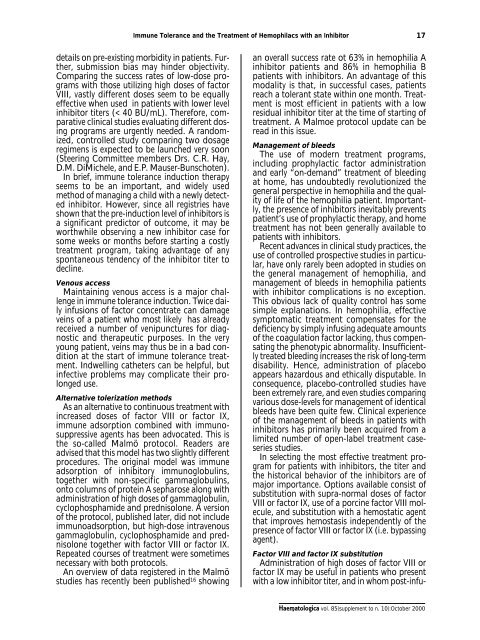Haematologica 2000;85:supplement to no. 10 - Supplements ...
Haematologica 2000;85:supplement to no. 10 - Supplements ...
Haematologica 2000;85:supplement to no. 10 - Supplements ...
Create successful ePaper yourself
Turn your PDF publications into a flip-book with our unique Google optimized e-Paper software.
Immune Tolerance and the Treatment of Hemophilacs with an Inhibi<strong>to</strong>r<br />
17<br />
details on pre-existing morbidity in patients. Further,<br />
submission bias may hinder objectivity.<br />
Comparing the success rates of low-dose programs<br />
with those utilizing high doses of fac<strong>to</strong>r<br />
VIII, vastly different doses seem <strong>to</strong> be equally<br />
effective when used in patients with lower level<br />
inhibi<strong>to</strong>r titers (< 40 BU/mL). Therefore, comparative<br />
clinical studies evaluating different dosing<br />
programs are urgently needed. A randomized,<br />
controlled study comparing two dosage<br />
regimens is expected <strong>to</strong> be launched very soon<br />
(Steering Committee members Drs. C.R. Hay,<br />
D.M. DiMichele, and E.P. Mauser-Bunschoten).<br />
In brief, immune <strong>to</strong>lerance induction therapy<br />
seems <strong>to</strong> be an important, and widely used<br />
method of managing a child with a newly detected<br />
inhibi<strong>to</strong>r. However, since all registries have<br />
shown that the pre-induction level of inhibi<strong>to</strong>rs is<br />
a significant predic<strong>to</strong>r of outcome, it may be<br />
worthwhile observing a new inhibi<strong>to</strong>r case for<br />
some weeks or months before starting a costly<br />
treatment program, taking advantage of any<br />
spontaneous tendency of the inhibi<strong>to</strong>r titer <strong>to</strong><br />
decline.<br />
Ve<strong>no</strong>us access<br />
Maintaining ve<strong>no</strong>us access is a major challenge<br />
in immune <strong>to</strong>lerance induction. Twice daily<br />
infusions of fac<strong>to</strong>r concentrate can damage<br />
veins of a patient who most likely has already<br />
received a number of venipunctures for diag<strong>no</strong>stic<br />
and therapeutic purposes. In the very<br />
young patient, veins may thus be in a bad condition<br />
at the start of immune <strong>to</strong>lerance treatment.<br />
Indwelling catheters can be helpful, but<br />
infective problems may complicate their prolonged<br />
use.<br />
Alternative <strong>to</strong>lerization methods<br />
As an alternative <strong>to</strong> continuous treatment with<br />
increased doses of fac<strong>to</strong>r VIII or fac<strong>to</strong>r IX,<br />
immune adsorption combined with immu<strong>no</strong>suppressive<br />
agents has been advocated. This is<br />
the so-called Malmö pro<strong>to</strong>col. Readers are<br />
advised that this model has two slightly different<br />
procedures. The original model was immune<br />
adsorption of inhibi<strong>to</strong>ry immu<strong>no</strong>globulins,<br />
<strong>to</strong>gether with <strong>no</strong>n-specific gammaglobulins,<br />
on<strong>to</strong> columns of protein A sepharose along with<br />
administration of high doses of gammaglobulin,<br />
cyclophosphamide and prednisolone. A version<br />
of the pro<strong>to</strong>col, published later, did <strong>no</strong>t include<br />
immu<strong>no</strong>adsorption, but high-dose intrave<strong>no</strong>us<br />
gammaglobulin, cyclophosphamide and prednisolone<br />
<strong>to</strong>gether with fac<strong>to</strong>r VIII or fac<strong>to</strong>r IX.<br />
Repeated courses of treatment were sometimes<br />
necessary with both pro<strong>to</strong>cols.<br />
An overview of data registered in the Malmö<br />
studies has recently been published 16 showing<br />
an overall success rate ot 63% in hemophilia A<br />
inhibi<strong>to</strong>r patients and 86% in hemophilia B<br />
patients with inhibi<strong>to</strong>rs. An advantage of this<br />
modality is that, in successful cases, patients<br />
reach a <strong>to</strong>lerant state within one month. Treatment<br />
is most efficient in patients with a low<br />
residual inhibi<strong>to</strong>r titer at the time of starting of<br />
treatment. A Malmoe pro<strong>to</strong>col update can be<br />
read in this issue.<br />
Management of bleeds<br />
The use of modern treatment programs,<br />
including prophylactic fac<strong>to</strong>r administration<br />
and early “on-demand” treatment of bleeding<br />
at home, has undoubtedly revolutionized the<br />
general perspective in hemophilia and the quality<br />
of life of the hemophilia patient. Importantly,<br />
the presence of inhibi<strong>to</strong>rs inevitably prevents<br />
patient’s use of prophylactic therapy, and home<br />
treatment has <strong>no</strong>t been generally available <strong>to</strong><br />
patients with inhibi<strong>to</strong>rs.<br />
Recent advances in clinical study practices, the<br />
use of controlled prospective studies in particular,<br />
have only rarely been adopted in studies on<br />
the general management of hemophilia, and<br />
management of bleeds in hemophilia patients<br />
with inhibi<strong>to</strong>r complications is <strong>no</strong> exception.<br />
This obvious lack of quality control has some<br />
simple explanations. In hemophilia, effective<br />
symp<strong>to</strong>matic treatment compensates for the<br />
deficiency by simply infusing adequate amounts<br />
of the coagulation fac<strong>to</strong>r lacking, thus compensating<br />
the phe<strong>no</strong>typic ab<strong>no</strong>rmality. Insufficiently<br />
treated bleeding increases the risk of long-term<br />
disability. Hence, administration of placebo<br />
appears hazardous and ethically disputable. In<br />
consequence, placebo-controlled studies have<br />
been extremely rare, and even studies comparing<br />
various dose-levels for management of identical<br />
bleeds have been quite few. Clinical experience<br />
of the management of bleeds in patients with<br />
inhibi<strong>to</strong>rs has primarily been acquired from a<br />
limited number of open-label treatment caseseries<br />
studies.<br />
In selecting the most effective treatment program<br />
for patients with inhibi<strong>to</strong>rs, the titer and<br />
the his<strong>to</strong>rical behavior of the inhibi<strong>to</strong>rs are of<br />
major importance. Options available consist of<br />
substitution with supra-<strong>no</strong>rmal doses of fac<strong>to</strong>r<br />
VIII or fac<strong>to</strong>r IX, use of a porcine fac<strong>to</strong>r VIII molecule,<br />
and substitution with a hemostatic agent<br />
that improves hemostasis independently of the<br />
presence of fac<strong>to</strong>r VIII or fac<strong>to</strong>r IX (i.e. bypassing<br />
agent).<br />
Fac<strong>to</strong>r VIII and fac<strong>to</strong>r IX substitution<br />
Administration of high doses of fac<strong>to</strong>r VIII or<br />
fac<strong>to</strong>r IX may be useful in patients who present<br />
with a low inhibi<strong>to</strong>r titer, and in whom post-infu-<br />
<strong>Haema<strong>to</strong>logica</strong> vol. <strong>85</strong>(<strong>supplement</strong> <strong>to</strong> n. <strong>10</strong>):Oc<strong>to</strong>ber <strong>2000</strong>
















